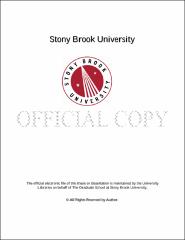| dc.identifier.uri | http://hdl.handle.net/11401/76987 | |
| dc.description.sponsorship | This work is sponsored by the Stony Brook University Graduate School in compliance with the requirements for completion of degree. | en_US |
| dc.format | Monograph | |
| dc.format.medium | Electronic Resource | en_US |
| dc.language.iso | en_US | |
| dc.publisher | The Graduate School, Stony Brook University: Stony Brook, NY. | |
| dc.type | Dissertation | |
| dcterms.abstract | <bold>Background</bold> Vascular remodeling reestablishes blood flow in the case of occlusions and can save tissue that would otherwise become hypoxic and necrotic. Vascular growth in an adult can occur in two ways: angiogenesis and/or arteriogenesis. While some pathways that govern the two are similar, the triggers have been found to be distinct. This study focuses on arteriogenesis- believed to be triggered by increases in wall shear stress (WSS) due to arterial occlusion. <bold>Hypothesis</bold> Inflammatory response will be initiated in an ex vivo femoral artery model in response to an increase in WSS. The inflammatory response will be detected by increases in TNFα , MCP-1, IL-2, P-Selectin, ICAM-1 and VCAM-1 expression. Inflammation alone (TNFα or shear stress induced) is not sufficient to initiate collateral vessel growth; monocyte recruitment and adhesion are required to see changes in vasculogenic growth factors VEGF, FGF-2, TGFβ and Egr-1. <bold>Methodology</bold> C57BL/6 mice will be used in an <italic>in vivo</italic> femoral artery excision model to study inflammatory response, monocyte recruitment, and vascular remodeling over 3 days post-occlusion. <italic>Ex vivo</italic> studies will then use isolated perfused femoral artery to show the monocyte adhesion cascade and collateral vessel initiation under inflammatory conditions, specifically inflammation caused by an increase in vascular WSS. <bold>Results/Conclusions</bold><italic> In vivo</italic> femoral artery excision (FAE) studies show significant increases in cytokines, adhesion molecules, monocytes and growth factors in the FAE samples over the contralateral. Inflammatory cytokines are expressed almost immediately after FAE in mouse. The resulting monocyte recruitment gives way to extravasation and proliferative arteriogenesis. The following<italic> ex vivo</italic> studies successfully defined a model for studying changes in WSS <italic>ex vivo</italic>, and show that the artery behaves by upregulating markers consistent with <italic>in vivo</italic> when subject to increases in WSS. Finally the perfusion of monocytes through the vessel results in adhesion when the endothelium is expressing inflammatory markers. The <italic>ex vivo</italic> femoral artery model can be used in future studies for longer time course analysis for vessel sprouting, as well as for studying inflammatory conditions initiated and treated in many different ways other than WSS. | |
| dcterms.available | 2017-09-20T16:51:36Z | |
| dcterms.contributor | Clark, Richard | en_US |
| dcterms.contributor | Frame, Mary D | en_US |
| dcterms.contributor | Rubenstein, David | en_US |
| dcterms.contributor | Rosengart, Todd. | en_US |
| dcterms.creator | Baldwin, Aparna Kadam | |
| dcterms.dateAccepted | 2017-09-20T16:51:36Z | |
| dcterms.dateSubmitted | 2017-09-20T16:51:36Z | |
| dcterms.description | Department of Biomedical Engineering. | en_US |
| dcterms.extent | 114 pg. | en_US |
| dcterms.format | Monograph | |
| dcterms.format | Application/PDF | en_US |
| dcterms.identifier | http://hdl.handle.net/11401/76987 | |
| dcterms.issued | 2013-12-01 | |
| dcterms.language | en_US | |
| dcterms.provenance | Made available in DSpace on 2017-09-20T16:51:36Z (GMT). No. of bitstreams: 1
Baldwin_grad.sunysb_0771E_11664.pdf: 3998081 bytes, checksum: 5f57ecc2b1b05bc28b406f4fa12753d5 (MD5)
Previous issue date: 1 | en |
| dcterms.publisher | The Graduate School, Stony Brook University: Stony Brook, NY. | |
| dcterms.subject | arteriogenesis, ex vivo perfusion, monocyte, remodeling, wall shear stress | |
| dcterms.subject | Biomedical engineering | |
| dcterms.title | An ex vivo femoral artery model to demonstrate inflammatory response and monocyte response following increased vascular wall shear stress | |
| dcterms.type | Dissertation | |

